1 level opening bids and responses in bridge
Most constructive auctions in bridge follow a simple pattern. New suits, limit bid, sign off.
You'll start by searching for the right suit to play in. Then one player will make a limit bid to show a specific strength and shape. That will enable partner to choose the final contract.
Constructive Bidding Overview
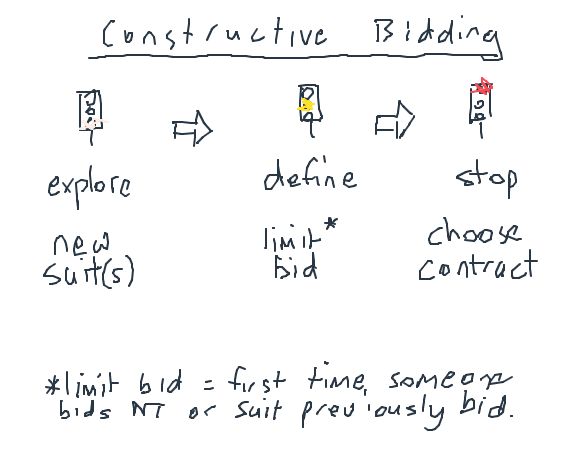
When your side opens the bidding 1♣, 1♦, 1♥ or 1♠ the responder, if changing suit, should keep the bidding as low as possible. That gives you more room to explore.
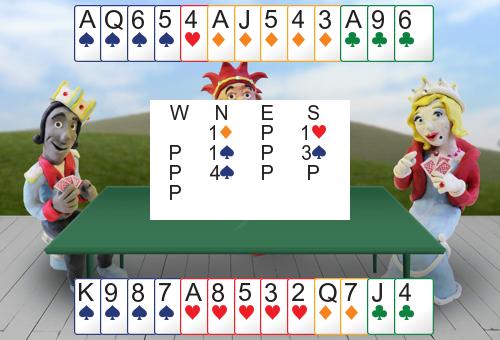
North starts with 1♦ and South bids a new suit, 1♥, keeping the bidding low. North bids another new suit, 1♠, still at a low level.
South raises to 3♠, a limit bid. After a limit bid, partner can often simply choose the final contract. North decides to bid game.
The basic flow of an auction as described above gives you a solid structure to base your bidding on.
Opening 1♣, 1♦, 1♥, 1♠
In most bidding systems, opening the bidding with 1 of a suit shows 12 or more points although you can open with less than that if you have good distribution.
In 5-card major bidding systems an opening bid of 1♥ or 1♠ needs to be a 5 card suit but an opening of 1♣ or 1♦ only needs to be a 3, or in some cases, 2 card suit.
In 4-card major bidding systems any opening bid of 1 of a suit only needs to be a 4 card suit.
With two 4-card suits there are different view on whether it's best to open the higher ranking suit, the lower ranking or use some other method of deciding.
A common approach is to open the higher ranking suit. If you're playing 4 card majors and you have a 4 card major then, heck, why not open the major? The exception is with four hearts and four spades it's better to open 1♥ to show the major and give partner the chance to show spades at the 1 level.
Another method is to open the lower ranking 4 card suit. This keeps the bidding lower and you end up with more room to explore.
You can also mix things up and open your 4-card major if it is a good one, otherwise open the minor.
Responder Changes Suit
Responder Changes Suit New suit at the 1-level = 6+ points New suit at the 2-level = 10+ points 1NT = 6-9, no 4 card suit to show at the 1-level

South's 1♠ bid shows 4+ spades and 6+points
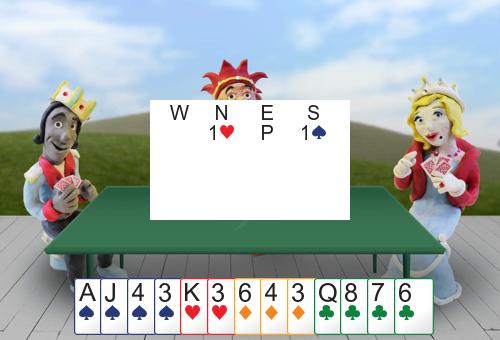
South has 10 points so is strong enough to bid at the 2-level if necessary but it's not necessary! 1♠ bid shows 4+ spades and 6+points. It's not 6-9, it's 6+.
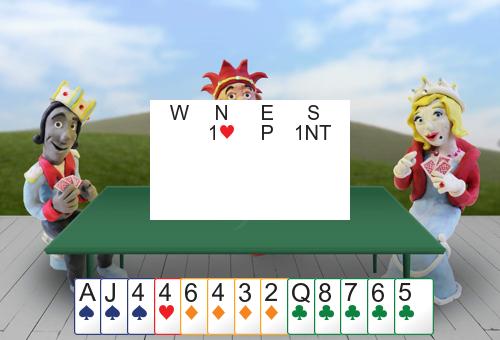
South isn't strong enough to bid 2♣ and so bids 1NT showing 6-9 with no 4 card suit to show at the 1-level.

South's 2♣ bid shows 4+ clubs and 10+points
In some bidding systems, bidding a new suit at the 2 level is forcing to game in other's it's just forcing for 1 round. Either way, it's good to have an agreement with partner!
Opener's Rebids
If responder changes suit then opener must bid again.
- Support responder with a fit
- Bid NT with a balanced hand
- Bid a new suit
- Rebid first suit
Opener bids NT
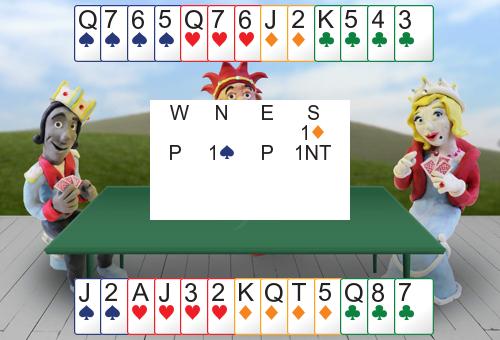
There's no need to bid hearts! If North has hearts he would have either bid them on the first round or else he'll bid them next round. The point count for the NT rebid depends on your bidding system.
Opener bids a second suit
Opener will normally try to show another suit on the second round of bidding rather than bidding the same suit twice.
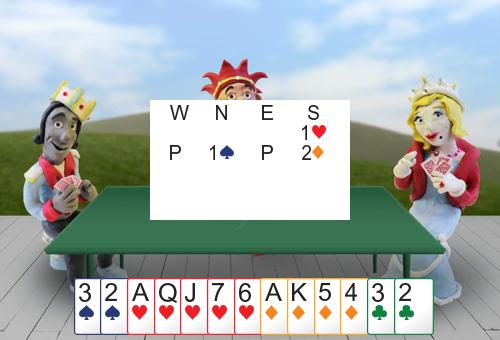
South shows the diamonds.
Opener's reverse
When opener bids a second suit at the 2-level in a higher ranking suit than the opening bid it's known as a reverse.
Opener's Reverse 17+ points unbalanced hand forcing
A reverse means that responder has to bid to the 3 level in order to return to opener's first suit.
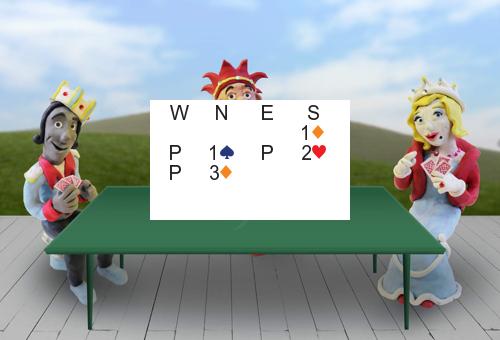
If North wants to go back to South's first suit it will need to be at the 3 level with a bid of 3♦.
If you're not strong enough to reverse, make the lowest bid you can that shows something extra about your hand.

South rebids diamonds.
Responding to a Reverse
Reverses are forcing so you have to keep bidding.

North has reversed showing 5 clubs, 4 diamonds and a strong hand.
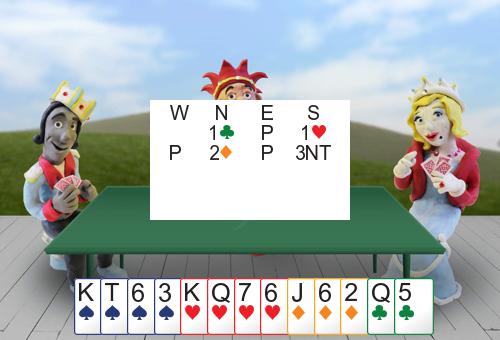
This time you are stronger and it's up to you to indicate your extra strength.
Responder's Rebids
Most of the time the responder can make a limit bid by now, if nobody has already.
Fourth suit forcing
If three suits have been bid at which point responder bids the only remaining unbid suit that's the fourth suit, of course, and it's forcing to game. It doesn't promise cards in that suit, 'fourth suit forcing' is just a convenient way to show a good hand.
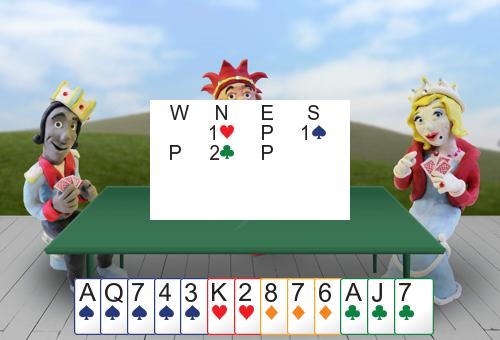
You have enough high card points to bid game, but which game? If partner had three card spade support, you would like to be in 4♠. If partner had a hold in diamonds, you would probably like to be in 3NT.
If partner had neither of the above, you might want to be in 4♥ or maybe even 5♣. Your dilemma is that you are too strong and have the wrong shape to bid either 3♥ (only 2 hearts) or 3♠ (shows 6+ spades). Without fourth suit forcing, you have to bid 3NT and cross your fingers. Even if partner has a diamond hold, like K5, it is much better they are declarer to prevent the opening leader playing ♦Q squashing the king under the third player's ace.
No problem, South bids 2♦, the fourth suit and partner must bid again.
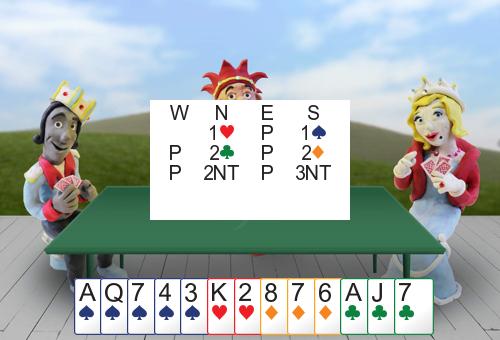
North shows a diamond stop and South raises to 3NT.
Responding to 4th suit forcing - support partner - bid no trumps - show extra length in your second suit - rebid your first suit with extra length or none of the above.
Limit Bids
Limit bids define the strength and shape of a hand and are the cornerstone of all natural bidding systems. The first time someone bids NT or a suit that has previously been bid then it's a limit bid. Now's the time to show your strength. You'll have plenty of room available to bid because you kept the bidding low in the early rounds!
Opener's notrump limit bids
Acol version 1
NT openings and rebids 1NT = 12-14 1x then 1N = 15-16 1x then 2N = 17-18 1x then 3N = 19 2N = 20-22 2♣ then 2N = 23-24 2♣ then 3N = 25+
Acol version 2
NT openings and rebids 1NT = 12-14 1x then 1N = 15-17 1x then 2N = 18-19 2N = 20-21 2♣ then 2N = 22-24 2♣ then 3N = 25+
Standard
NT openings and rebids 1NT = 15-17 1x then 1N = 12-14 1x then 2N = 18-19 2N = 20-21 2♣ then 2N = 22-24 2♣ then 3N = 25+
Keep in mind that things change in a competitive auction.
Responder's notrump limit bids
NT responses 1N = 6-9 2N = 10-12 3N = 13-15
Responder's suit limit bids
Suit responses 1x - 2x = 6-9 - 3x = 10-12 - 4x = 13-15 ( but not on the first round )
Choose the final contract
After a limit bid, partner will normally be able to choose the final contract but there are times when the auction might continue.
Inviting to game with a trial bid
Trial bids are a way of inviting to game after a trump fit has been found. There are different agreements you can have as to what a trial bid shows. Some players play short suit trial bids, others play long suit or help suit trial bids. No right or wrong, just what fits your partnership style.
Help suit trial bids 1♥ - 2♥ -- 3♣ Something like ♣KJx
On the following hand you open 1♥, partner makes a limit bid by raising to 2♥ and you have to decide whether or not to try for game.
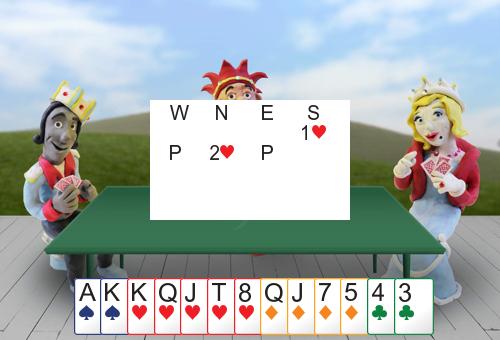
You know partner has between 6-9 points. What more would you really like to know about partner's hand? Would you like to know whether partner was minimum or maximum for the 2♥ bid? 6 points or 9 points? That would be some help, I guess.
What if you could find out whether partner had the ♦A or ♦K! Now that would be useful! If partner has a fitting honour for your diamonds it will really help establishing that suit.

Partner says yes. Game makes.
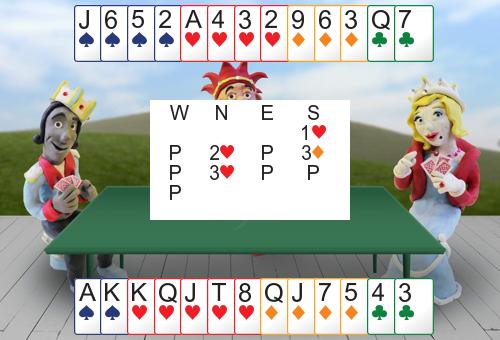
Partner says no. 3♥ is high enough
tags: #constructivebidding
